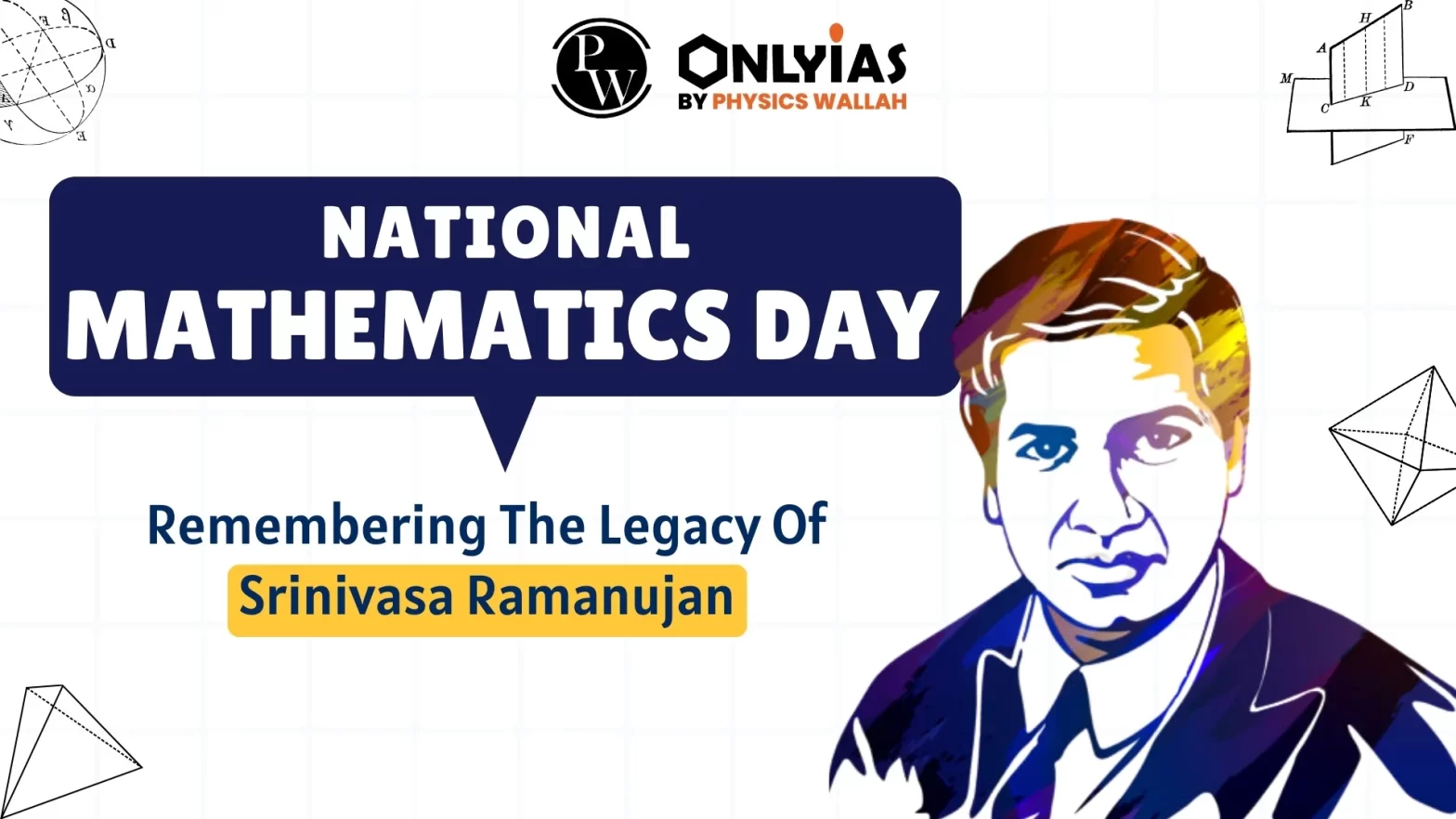Context: This article is based on an Editorial “National Mathematics Day: Remembering the legacy of Srinivasa Ramanujan” which was published in the Indian Express.
Every year, on December 22nd, the birth anniversary of legendary mathematician Srinivasa Ramanujan (1887-1920), is celebrated as National Mathematics Day.
- In 2012, then Prime Minister Manmohan Singh declared December 22 as National Mathematics Day in honor of the great man.
| Relevancy for Prelims: Srinivasa Ramanujan and his Contribution. |
About Srinivasa Ramanujan: His Early Life
- Birth: Srinivasa Ramanujan was born on 22nd December 1887 in the town of Erode in Madras Presidency (now Tamil Nadu), to a Brahmin Iyengar family.
- Excelled in Mathematical Aptitude: By the age of 14, he was completing mathematics examinations in half the allotted time, and exploring complex topics way beyond the capability of an average 14-year-old.
|
“The Man Who Knew Infinity”:
- His biography by Robert Kanigel depicts his life and journey to fame.
- A film of the same name was released in 2015 in which British-Indian actor Dev Patel played Ramanujan.
|
Must Read: National Mathematics Day 2023, here.
Srinivasa Ramanujan: A Chronology of his Achievement
- In 1904: After finishing secondary school, Srinivasa Ramanujan received a scholarship at the Government Arts College, Kumbakonam. However, due to his dislike for non-mathematical subjects, he failed in most other subjects and thus lost the scholarship.
- By 1910: He was gaining popularity in Madras’ mathematical circles.
- In 1911: He published the first of his papers in the Journal of the Indian Mathematical Society.
- In 1912: V Ramaswamy Iyer, founder of the Indian Mathematical Society, helped him get a clerical position at the Madras Port Trust.
- In 1913: Impressed with Ramanujan’s theorems and work related to infinite series, the Cambridge-based GH Hardy called him to London.
- In 1914: He traveled to England and with Hardy’s help, got enrolled in Trinity College, Cambridge, where Hardy tutored him and collaborated with him in some 20 research papers (between 1914 and 1919).
- In 1917: He was elected to be a member of the London Mathematical Society.
- In 1918: He was elected to the prestigious Royal Society for his research on Elliptic Functions and theory of numbers, becoming one of the youngest to ever achieve the feat.
- He was also the first Indian to be elected a Fellow of Trinity College.
Srinivasa Ramanujan: His Major Contributions to Mathematics
- Infinite Series for pi: In 1914, Srinivasa Ramanujan found a formula for infinite series for pi. Finding an accurate approximation of π (pi) has been one of the most important challenges in the history of mathematics.
- Game Theory: His contribution to game theory is purely based on intuition and natural talent and is unmatched to this day.
- Mock Theta Function: He elaborated on the mock theta function, a concept in the field of modular forms of mathematics. It has found applications in the study of black holes.
- Ramanujan Number: 1729 is known as the Ramanujan number which is the sum of the cubes of two numbers 10 and 9.
- Circle Method: Ramanujan, along with GH Hardy, invented the circle method which gave the first approximations of the partition of numbers beyond 200.
- This method contributed significantly to solving the notorious complex problems of the 20th century, such as Waring’s conjecture and other additional questions.
- Theta Function: It is a special function of several complex variables.
- German mathematician Carl Gustav Jacob Jacobi invented several closely related theta functions known as Jacobi theta functions.
- Theta function was studied extensively by Ramanujan who came up with the Ramanujan theta function, which is used to determine the critical dimensions in Bosonic string theory, superstring theory, and M-theory.
- His Significant Contributions: Mathematical fields such as complex analysis, number theory, infinite series, continued fractions, Riemann series, elliptic integrals, partition functions (a partition is a way to represent a positive integer. For example, 1+1+1+1 is a partition of 4, 1+3 is another partition of 4, and so on), modular forms, hypergeometric series (the terms in every consecutive pair in the series form rational functions), and the functional equations of the zeta function.
- Srinivasa Ramanujan discovered his own theorems and independently compiled 3,900 results.
- Ramanujan Conjecture: It was published in 1916 and was proved in 1973 by Pierre Deligne.
- It inspired the development of theory of Galois representation that was employed in Andrew Wiles’ proof of Fermat’s last theorem published in 1995.
- In recent years, Srinivasa Ramanujan works and their extensions have found applications in signal processing to identify periodic information, akin to Fourier analysis.
Srinivasa Ramanujan: His Later Stage
- In 1919: Ramanujan returned to India from England.
- Ramanujan spent his last year producing some of his most profound mathematics.
- In 1920: At just 32 years of age, he breathed his last owing to deteriorating health.
- He was diagnosed with tuberculosis which was later revised as hepatic amoebiasis.
- After his death, Srinivasa Ramanujan left behind three notebooks and some pages containing unpublished results, on which mathematicians continued to work for many years.
Conclusion
Srinivasa Ramanujan stands as a luminary in the realm of mathematics, earning recognition as one of India’s greatest geniuses. His impactful contributions to the analytical theory of numbers, coupled with groundbreaking work on elliptic functions, continued fractions, and infinite series, have left an indelible mark on the discipline.
![]() 23 Dec 2023
23 Dec 2023

